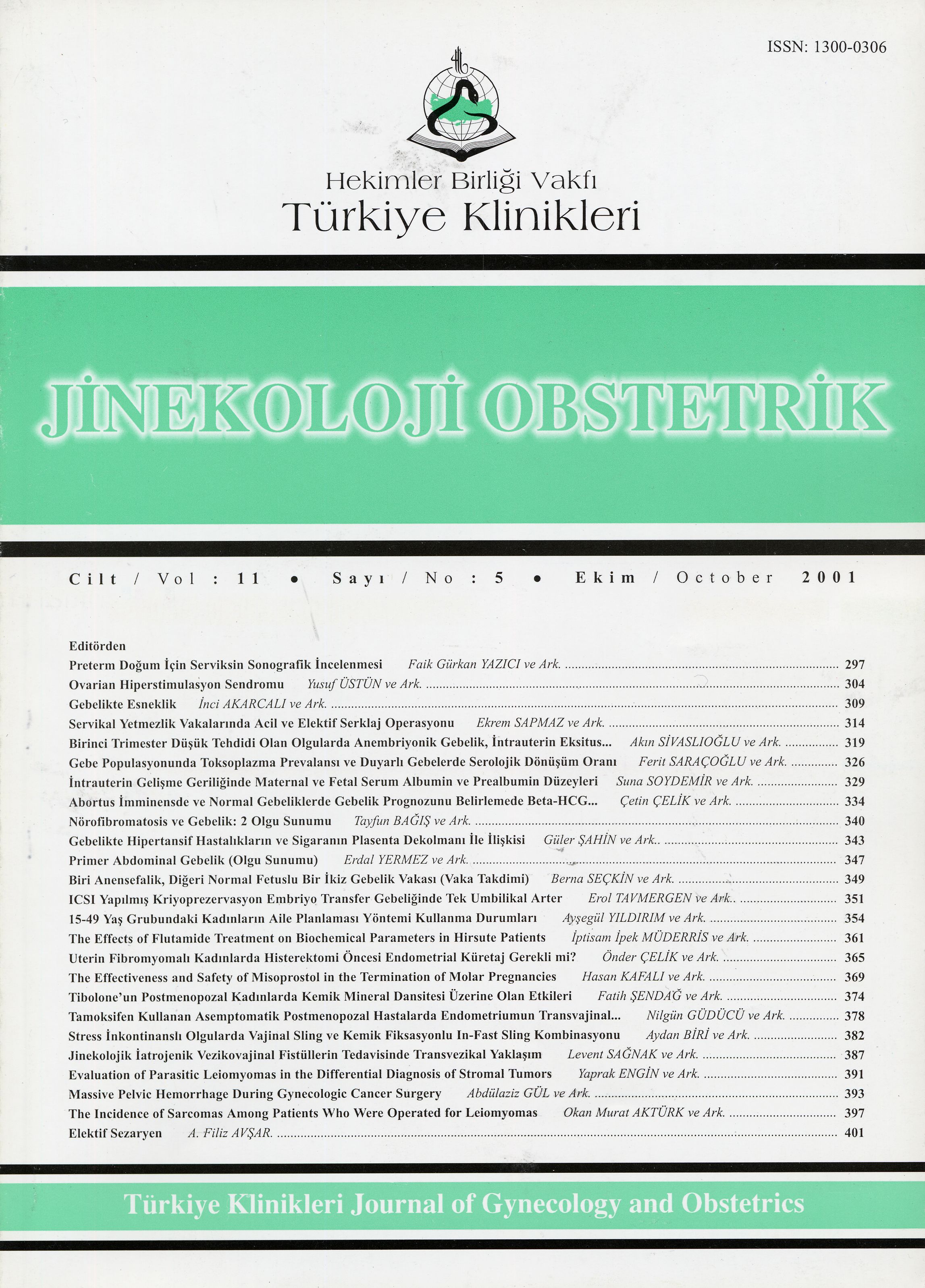Open Access
Peer Reviewed
ARTICLES
2326 Viewed1258 Downloaded
A Twin Gestation Discordant for Anencephaly (Case Report)
Biri Anensefalik, Diğeri Normal FetusluBir İkiz Gebelik Vakası (Vaka Takdimi)
Turkiye Klinikleri J Gynecol Obst. 2001;11(5):349-50
Article Language: TR
Copyright Ⓒ 2020 by Türkiye Klinikleri. This is an open access article under the CC BY-NC-ND license (http://creativecommons.org/licenses/by-nc-nd/4.0/)
ÖZET
Amaç: Fetuslardan birinin anensefalik olduğu bir ikiz gebelik vakasını takdim etmek, diğer ikiz eşinin de anensefalik olma riskini incelemek ve prenatal tanı metodlarının önemini tartışmak. Olgu Sunumu: Hasta 33. gebelik haftasında iken, preterm eylem tanısıyla kliniğimize yatırıldı. Ultrasonografik inceleme sonucu, fetuslardan birinin anensefalik olduğu tesbit edildi; aynı gün fetal distress tanısıyla sezaryen uygulandı. Operasyon sırasında, farklı cinsiyette ikiz eşleri ve diamniyotik-dikoryonik plasenta olduğu gözlendi. Anensefalik fetus, kısa bir süre sonra ölürken, diğer ikiz eşinin prematürite dışında tamamen sağlıklı olduğu görüldü. Sitogenetik çalışmada, her iki ikiz eşinde de patoloji saptanmadı. Sonuç: Ultrasonografi, ikiz gebeliklerde anomali tesbitinde kullanılabilecek en uygun tanı yöntemi olarak gözükmektedir. İkiz eşlerden birinde anomali saptandığında, diğer fetus da detaylı olarak incelenmeli ve yoğun parenteral takibe alınmalıdır.
Amaç: Fetuslardan birinin anensefalik olduğu bir ikiz gebelik vakasını takdim etmek, diğer ikiz eşinin de anensefalik olma riskini incelemek ve prenatal tanı metodlarının önemini tartışmak. Olgu Sunumu: Hasta 33. gebelik haftasında iken, preterm eylem tanısıyla kliniğimize yatırıldı. Ultrasonografik inceleme sonucu, fetuslardan birinin anensefalik olduğu tesbit edildi; aynı gün fetal distress tanısıyla sezaryen uygulandı. Operasyon sırasında, farklı cinsiyette ikiz eşleri ve diamniyotik-dikoryonik plasenta olduğu gözlendi. Anensefalik fetus, kısa bir süre sonra ölürken, diğer ikiz eşinin prematürite dışında tamamen sağlıklı olduğu görüldü. Sitogenetik çalışmada, her iki ikiz eşinde de patoloji saptanmadı. Sonuç: Ultrasonografi, ikiz gebeliklerde anomali tesbitinde kullanılabilecek en uygun tanı yöntemi olarak gözükmektedir. İkiz eşlerden birinde anomali saptandığında, diğer fetus da detaylı olarak incelenmeli ve yoğun parenteral takibe alınmalıdır.
ANAHTAR KELİMELER: İkiz gebelik, anomali, anensefali
ABSTRACT
Objective: To present a case of the twin pregnancy in which one of the pairs was anencephalic, to evaluate the concordance rates in twins for anencephaly and to discuss the importance of prenatal diagnostic methods. Case Report: The patient was hospitalized at 33 weeks gestation with the diagnosis of preterm labor. Ultrasonographic evaluation has revealed that one of the twins was anencephalic. Cesarean section was performed at the same day by the indication of fetal distress. During the operation, opposite sexed pairs and diamniotic-dichorionic plasenta was observed. Anensephalic fetus died soon after the operation, co-twin was completely healthy apart from prematurity. Cytogenetic evaluation revealed no abnormality in either of the twins. Result: Ultrasonographic examination looks like the most useful method for the diagnosis of structural defects on twin gestations. When anomaly is found in only one fetus of a twin pair, the anatomy of the other fetus should be examined carefully and intensive prenatal care have to be obtained.
Objective: To present a case of the twin pregnancy in which one of the pairs was anencephalic, to evaluate the concordance rates in twins for anencephaly and to discuss the importance of prenatal diagnostic methods. Case Report: The patient was hospitalized at 33 weeks gestation with the diagnosis of preterm labor. Ultrasonographic evaluation has revealed that one of the twins was anencephalic. Cesarean section was performed at the same day by the indication of fetal distress. During the operation, opposite sexed pairs and diamniotic-dichorionic plasenta was observed. Anensephalic fetus died soon after the operation, co-twin was completely healthy apart from prematurity. Cytogenetic evaluation revealed no abnormality in either of the twins. Result: Ultrasonographic examination looks like the most useful method for the diagnosis of structural defects on twin gestations. When anomaly is found in only one fetus of a twin pair, the anatomy of the other fetus should be examined carefully and intensive prenatal care have to be obtained.
MENU
POPULAR ARTICLES
MOST DOWNLOADED ARTICLES





This journal is licensed under a Creative Commons Attribution-NonCommercial-NoDerivatives 4.0 International License.











